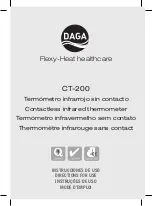
31
6.6 8048 Microprocessor
The 8 bit signal chip 8048 microprocessor is configured with P1 as the analog-to-digi-
tal input port, P2 as a control/status port, and the b-directional data port, DB, as the
display driver output port. Test ports T1 and T2 are used to sense the LED/LCD config-
uration flag and the peak hold request respectively. Figure 6-2 (Microprocessor
Control Functions) contains the software design specification which gives a more
detailed description of the port pin allocations and the general flow of the micro-
processor control function.
6.7 Waveforms and Timing Diagrams
The Intersil 7109 has an internal clock working with a firmware delay loop such that
the display updates at approximately three times per second.
The cycle begins when the microprocessor raises RUN, U5-26. After the analog-to-
digital converter initialization sequence, the integrator begins ramping up U5-32, the
ramp rate determined by the input voltage, VIN. After 2048 clock counts, it begins to
ramp down, the ramp rate portional to VIN. The number of counts to zero crossing is
a measure of VIN. The STATUS flag (U5-2) is now dropped informing the micro-
processor of conversion completion. The 8048 drops RUN, alternately dropping and
rising HBEN (U5-18) and LBEN (U5-19) to read the high and low bytes of the 12 bit
digital count. Once processed and ready for display, the microprocessor, U7, raises
MODE (U7-21) and writes a control word to the LED display driver. MODE is then
dropped and write pulses (U7-10) load the 5 display digits sequentially (MSD-LSD).
Four more dummy writes occur to clear the driver, U8, control logic. The LCD display
sequence is similar and presented at the bottom of Figure 6-2.
Summary of Contents for 2500MX
Page 8: ...4 Figure 2 1 Digital Heat Prober Major Features...
Page 14: ...10 Figure 3 2 Standard Wahl Probes Figure 3 3 Extension Probe Handle...
Page 16: ...12 Figure 3 4 Molten Metal Dipstick...
Page 28: ...24 Figure 5 2 Heat Prober with Wahl Calibrator...
Page 29: ...25 TP2 R29 R9 R20 TP1 R22 TP3 U 3 Figure 5 3 LED Adjustment Points...
Page 30: ...26 TP2 R29 R9 R20 TP1 R22 TP3 U 3 Figure 5 4 LCD Adjustment Points...
Page 32: ...28 Figure 6 1 Program Flow Chart...
Page 43: ...39 Figure 8 1 Block Diagram...
Page 44: ...40 Figure 8 2 LED Component Layout...
Page 45: ...41 Figure 8 3 LCD Component Layout...
Page 54: ...50 Figure 11 1 2500M Accessories and Special Purpose Probes...
















































